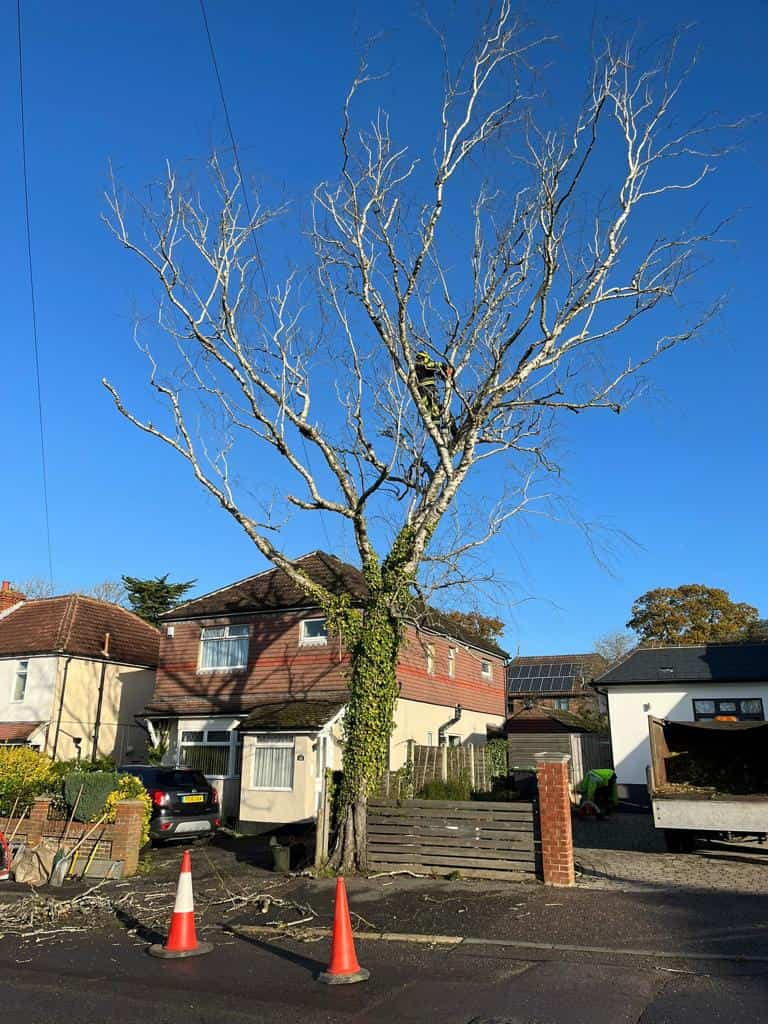Introduction
Tree pruning is more than a cosmetic task—it is a critical part of maintaining tree health and preventing disease. When carried out professionally, pruning enhances airflow through the canopy, reduces the risk of fungal infections, and encourages strong, balanced growth. In areas like Fordham, Cambridge, where gardens and woodlands are an integral part of the landscape, regular pruning plays a key role in sustainable tree care.
At Fordham Tree Surgeons, we understand how strategic pruning can improve both the structure and longevity of your trees. This article explains how improved airflow helps combat disease and why professional tree pruning is a valuable investment in your landscape.
The Relationship Between Airflow and Tree Health
Airflow within a tree’s canopy is essential for maintaining the right microclimate. Dense, unpruned canopies trap moisture, creating the perfect environment for fungal spores and bacterial growth.
Effects of Poor Air Circulation
- High humidity levels around branches and foliage
- Increased leaf wetness, particularly after rainfall
- Limited sunlight penetration, slowing photosynthesis and drying
- Stagnant conditions, which promote mildew, mould, and pathogens
Pruning opens up the canopy, allowing air to flow freely and helping excess moisture to evaporate more quickly.
Pruning Techniques That Promote Airflow
Crown Thinning
Crown thinning is the selective removal of branches throughout the crown to reduce its density without altering its overall shape or size.
- Improves air movement between limbs
- Allows more sunlight to reach internal leaves and lower plants
- Reduces wind resistance, lowering the chance of storm damage
Crown thinning is particularly useful for broadleaf trees with thick canopies.
Crown Lifting
This involves removing the lower branches of a tree to increase clearance from the ground or structures.
- Improves air circulation at lower levels
- Enhances understorey plant health
- Reduces shading on nearby lawns or garden features
In domestic and urban settings around Fordham, this technique is often used to create a safer and more attractive environment.
Deadwood Removal
Removing dead or decaying branches is crucial, as these parts often harbour disease and obstruct airflow.
- Prevents the spread of decay
- Enhances the tree’s structure and appearance
- Improves air penetration across all canopy layers
Deadwood removal should always be carried out with care to avoid stress to the tree.
Disease Prevention Through Pruning
Tree diseases often thrive in warm, damp, and shaded conditions—environments that overgrown trees unintentionally create.
Common Diseases Reduced by Pruning
- Powdery mildew – flourishes in humid, stagnant conditions
- Leaf spot diseases – spread rapidly without adequate air and light
- Cankers and blights – enter through wounds and affect stressed trees
- Root and collar rot – made worse by reduced airflow and heavy shading
Pruning reduces the chances of infection and improves the tree’s ability to resist stress-related illnesses.
Timing and Precision: Key to Effective Pruning
Pruning at the right time of year and with the correct technique is vital for success.
Best Practices for Healthy Pruning
- Winter or early spring – ideal for most structural pruning as the tree is dormant
- Dry weather conditions – lower the risk of pathogen entry through cuts
- Sterilised tools and sharp blades – ensure clean cuts that heal quickly
- Avoid over-pruning – removing too much foliage can weaken the tree and make it more vulnerable
At Fordham Tree Surgeons, we assess each tree individually, considering species, age, and location before recommending a pruning schedule.
Long-Term Benefits of Improved Airflow
Enhanced airflow doesn’t just prevent disease—it offers broader ecological and practical advantages.
Additional Benefits of Airflow-Focused Pruning
- Improved fruit and flower production
- Healthier understorey plants due to better light and reduced humidity
- Greater resistance to storms and heavy winds
- Increased aesthetic value with well-shaped, vibrant trees
For property owners in Fordham, Cambridge, maintaining trees with a focus on airflow means creating safer, healthier, and more visually pleasing landscapes.
Conclusion
Tree pruning is an essential part of maintaining tree health and vitality. By enhancing airflow, it reduces the risk of disease, improves structural integrity, and supports a thriving garden ecosystem. Strategic pruning carried out by experienced professionals can transform not only the appearance of your trees but their resilience and lifespan too.
At Fordham Tree Surgeons, we provide expert tree care throughout Fordham, Cambridge, with a focus on sustainable practices and client satisfaction. If you’re concerned about your trees or simply want to improve their condition, contact us to arrange a consultation. Let us help you create a healthier, more balanced outdoor environment.
Call us on: 01206 581 299
Click here to find out more about Fordham Tree Surgeons
Click here to complete our contact form and see how we can help with your tree care needs.

